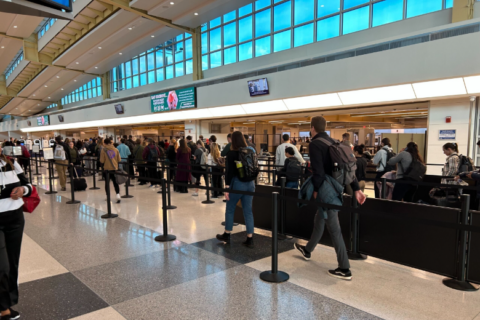Navigating the complex and ever-changing miles and points universe is a challenging task for any traveler. Once you pinpoint the programs that offer a variety of redemption options and elite status privileges, you also have to determine which program best fits your lifestyle and travel goals. And with a myriad of programs to pick from, each touting its own perks, business models and affiliated credit cards, it’s difficult to know which ones are the most rewarding.
That’s why U.S. News tapped five experts to reveal their secrets for mastering the rewards game. Here are their top strategies for leveraging points and getting the most out of membership.
Know where you want to go with your points and miles
“At the high level, you need to identify the type of travel you want to redeem for,” explained Brian Kelly, the guru behind the points and miles advice site The Points Guy. For example, if you’re an infrequent traveler who wants to collect enough points for free domestic coach flights, you need to take a different approach than an international traveler who wants to fly in first class to the Maldives.
Ask yourself key questions, such as “Do I want upgrades?” and “Do I want an international trip?” suggested Seth Miller, author of The Wandering Aramean, an advice blog featured on the points site BoardingArea. Once you’ve determined what you want your miles to do for you, you can shift your “earning style and earning efforts” based on your objectives, he explained.
One of the most compelling reasons to adopt a new earning strategy? The rise of revenue-based programs like those offered by Delta and United. These programs award travelers based on dollar spent rather than mile flown, making earning enough points to use for free flights increasingly difficult for infrequent leisure travelers. As a result, frequent fliers are trying new tactics. “The kicker is, for a lot of travelers, traveling is no longer the main earnings avenue,” Miller said. “If you’ve got someone who does a lot of business expenses, they can earn points faster with a credit card.”
Invest in the right credit card
“If you’re going to fly domestically in economy, get a cash back card with the strongest return,” advised Gary Leff, co-founder of MilePoint and author of frequent flier site View From the Wing. Cards such as the Fidelity Investment Rewards American Express or Citi Double Cash Back Card allow you to get up to 2 percent cash back per dollar spent on purchases and do not require annual fees. While you won’t be able to earn miles or loyalty points with either card, you’ll maximize savings for a future award trip.
On the other hand, if you want to travel internationally, Leff suggested choosing a flexible card that allows you to transfer points to a variety of programs. That way, when it comes time to redeem, you can apply points where you want them. “Chase Sapphire rewards will give you double points on all travel and dining,” Leff explained. Plus, you can transfer your points to major loyalty and airline programs, such as Southwest, United, Marriott and IHG. Leff also highlighted the American Express Everyday Preferred Card as a smart choice, because it awards members a 50 percent bonus (or a base of 1.5 points per dollar on purchases) for using the card 30 times per month.
Diversify your program portfolio and stay on top of your points
“The tip now, more than ever, is to diversify,” Kelly said. Beyond choosing a flexible card that allows you to transfer points, it’s important “not to peg yourself into one trip,” he explained, emphasizing that the points that yield the greatest value are those that can be redeemed across multiple programs. Starwood, for instance, boasts more than 30 airline partners — including American, Delta and Alaska — making it an ideal pick for those looking to take advantage of transferable points.
Still, to improve your chances of cashing in points for the awards that matter most to you, it’s best not to “over-diversify,” explained Ben Schlappig, author of One Mile at a Time, a travel blog for aviation and points enthusiasts.
Savvy fliers must also monitor their account activity. “The reasons some of these programs wind up being so lucrative is in fact because they’re so complicated,” explained Leff. A simple and strategic way to track your activity across multiple platforms is to use a tool like AwardWallet, a free service that keeps everything (like account numbers and mileage balances) in one place, he explained.
Understand the value of your points before collecting them
“The easiest way to rack up points quickly is to pay more,” explained Scott Mackenzie, the creator of the travel advice blog Travel Codex. If you can afford to pay a premium rate, “those fares will sometimes earn you two to three times more,” compared to an economy-class ticket, he said. This is an especially effective strategy if you’re a business traveler logging hundreds of flights a year on the company dime. Still, it’s important to factor in both the earning and redemption opportunities available with each program.
“A round-trip economy ticket should generally be 25,000 miles with American, Delta or United,” explained Schlappig. “If you’re spending more than that, you’re likely overpaying, and keep in mind that those programs also offer round-trip awards to Europe for just 60,000 miles in economy, so the 50,000-mile domestic awards are a comparatively terrible deal.”
Hotel loyalty programs also have varied earning and redemption requirements, so to optimize your awards potential, make sure you “know how many points are required for a given reward,” noted Schlappig. “Hilton points, for example, are easy to rack up, but free nights require many more points than other chains.”
A program’s variety of redemption partners is another factor to consider. “Understanding what the options are and who the partners are involved and what the fees might be associated with award tickets” is a critical component for understanding value, Miller explained. For example, if your dream is to travel to Europe, you may not want to choose American because its partner, British Airways, charges extra fuel surcharges on its flights. So let’s say you wanted to cash in American AAdvantage miles for an award flight with British Airways, you would end up paying additional fees. In contrast, United does not impose taxes or surcharges on its award tickets. In short, know the associated fees for award flights.
Consider the cost of seeking elite status perks
“Elite status has continued to be watered down,” explained Kelly. With airlines raking in billions each year, there’s little incentive for them to reward fliers with elite tier benefits. And with the pool of loyalty members holding top-tier elite status shrinking, attaining top-tier status has become increasingly more difficult and less valuable, he said.
So, which status-seeking strategy should you go with? “If you are a frequent business traveler, or have a significant amount of travel planned for the following year, then it can make sense to ‘buy up’ to elite status,” explained Schlappig, but as a general rule of thumb, skip investing in elite status unless you’re flying more than 50,000 miles a year. And while there’s no hard and fast rule for seeking status in hotel loyalty programs, Schlappig pointed out that “many hotels offer mid-tier elite status just for having their co-branded credit card, so unless you’re going to stay 25 nights or more with a single chain you’re likely best off being brand agnostic.”
More from U.S. News
How to Pick the Right Travel Rewards Program for You
2015-16 Best Airlines Rewards Programs
Rewards 101: A Guide to Maximizing Points and Miles originally appeared on usnews.com






